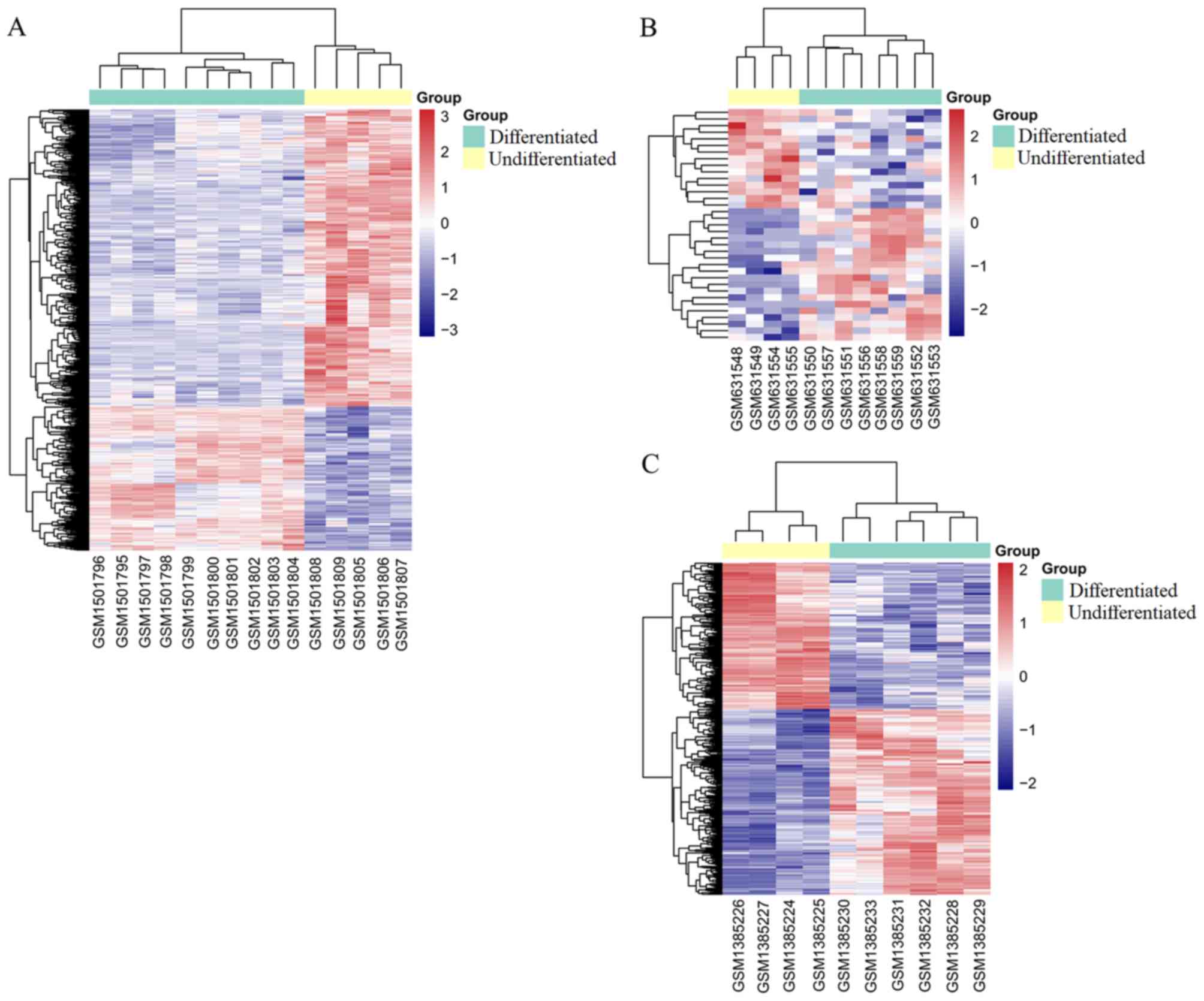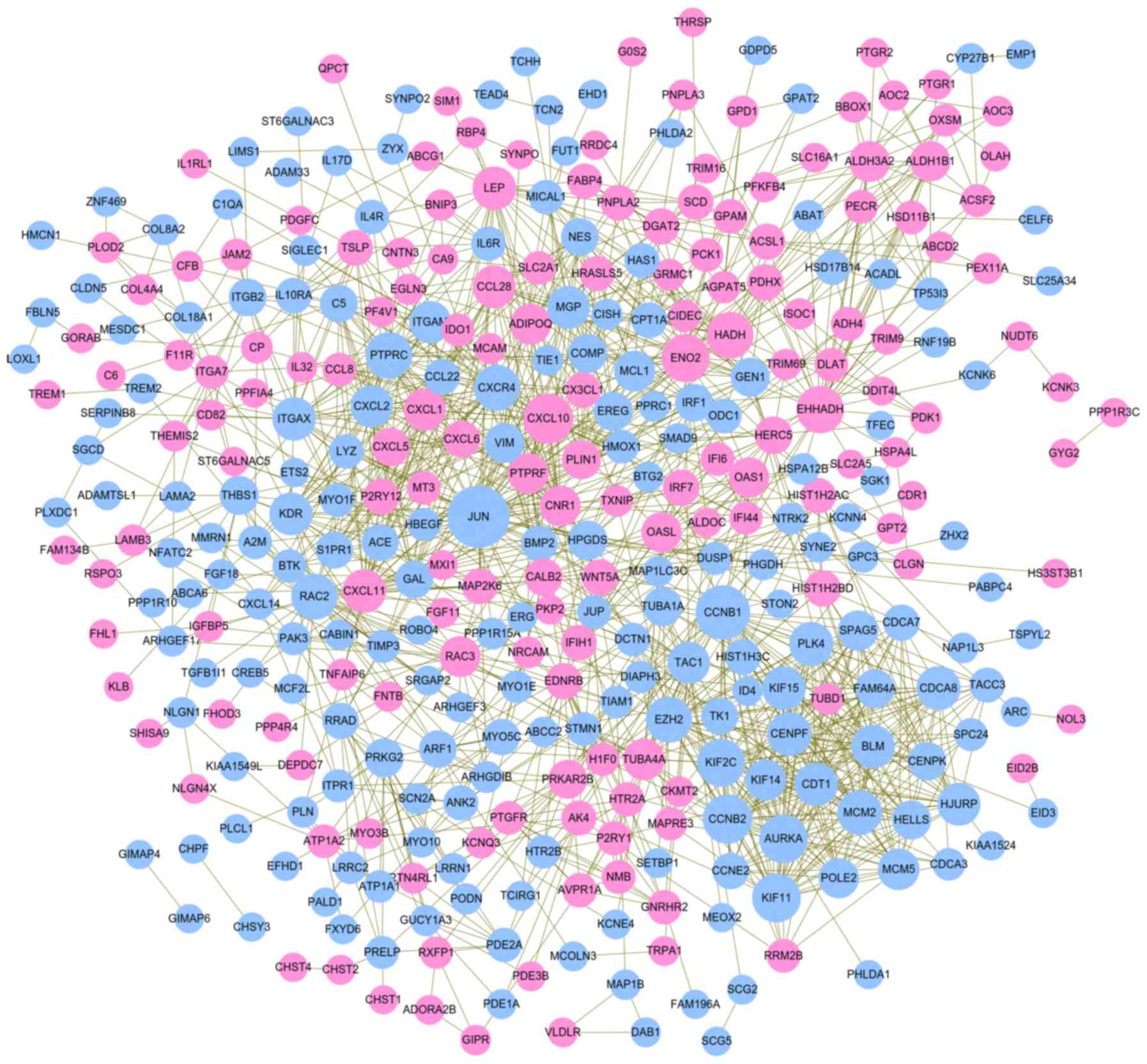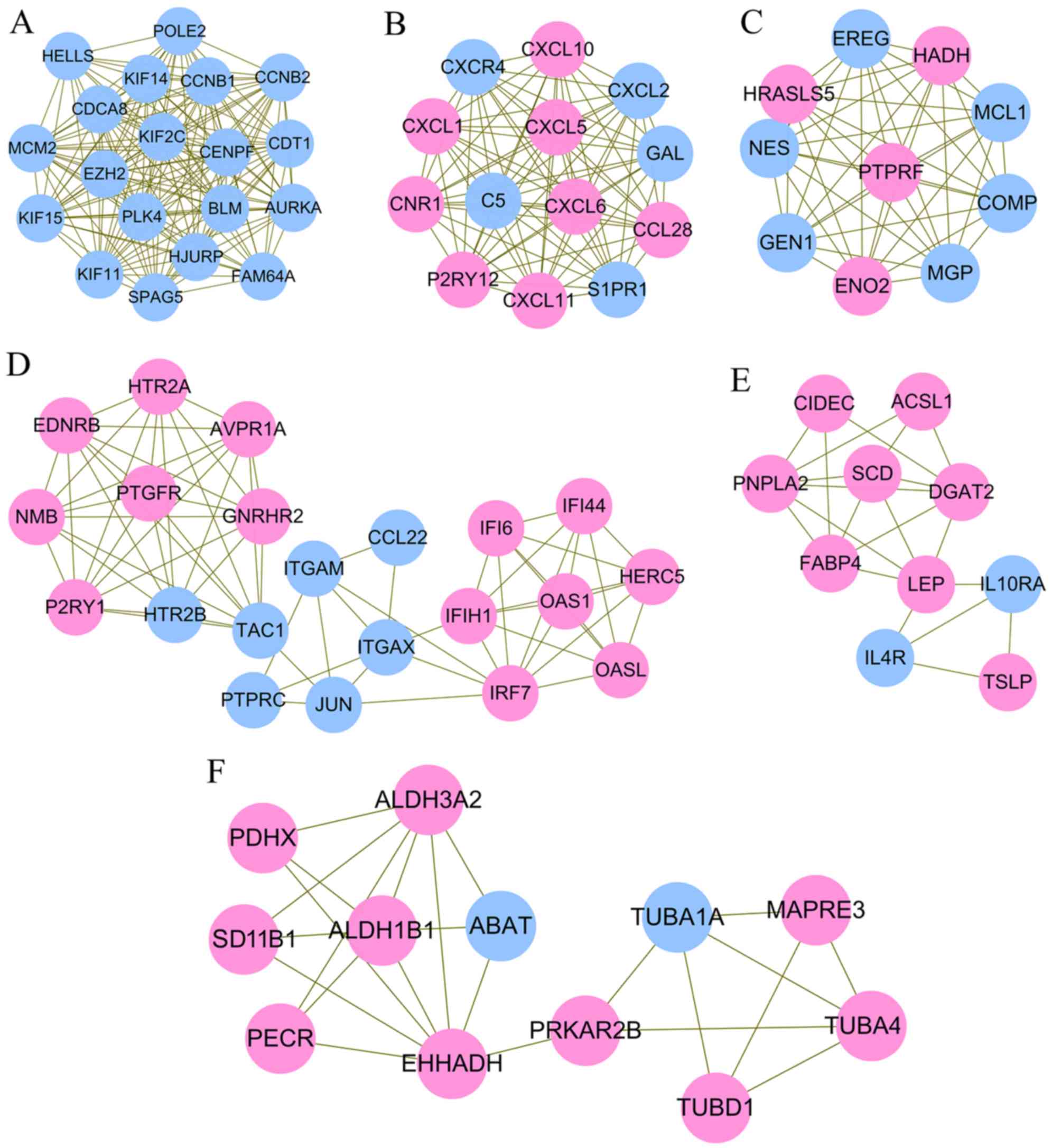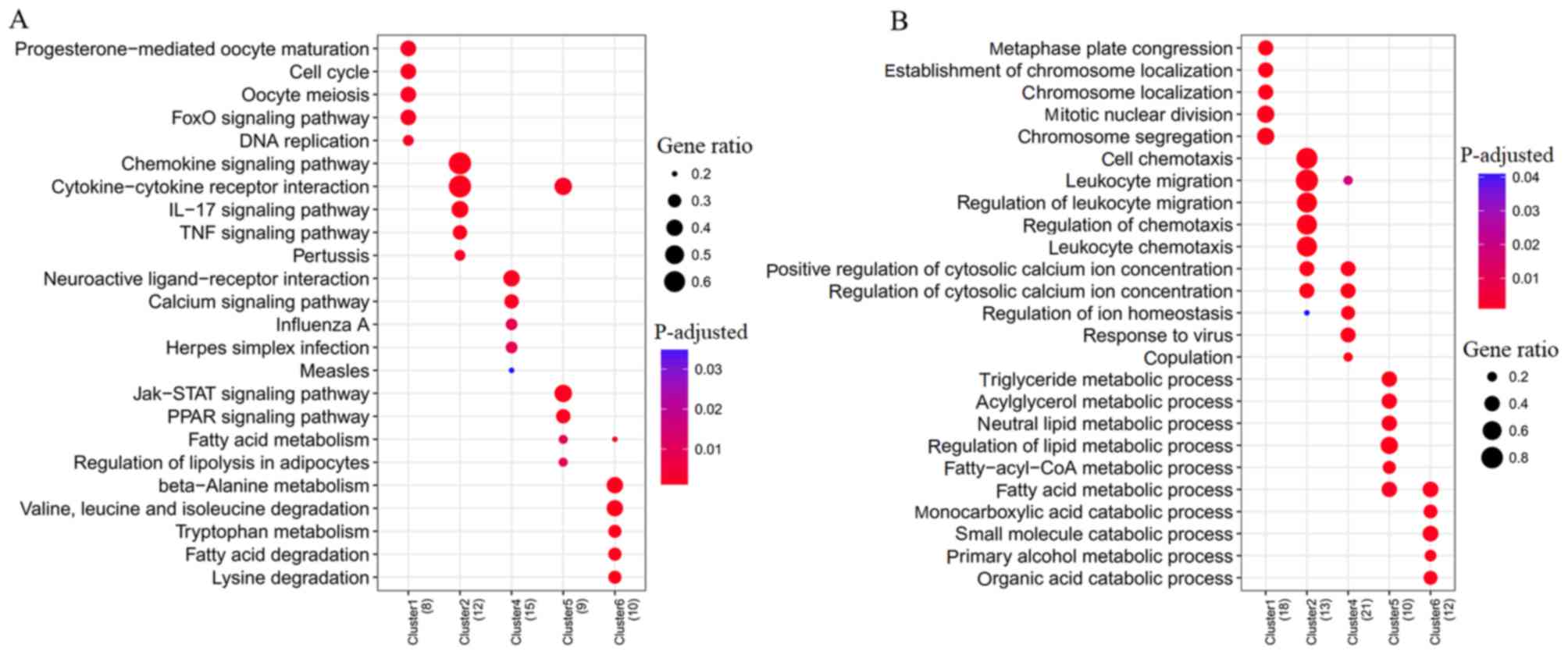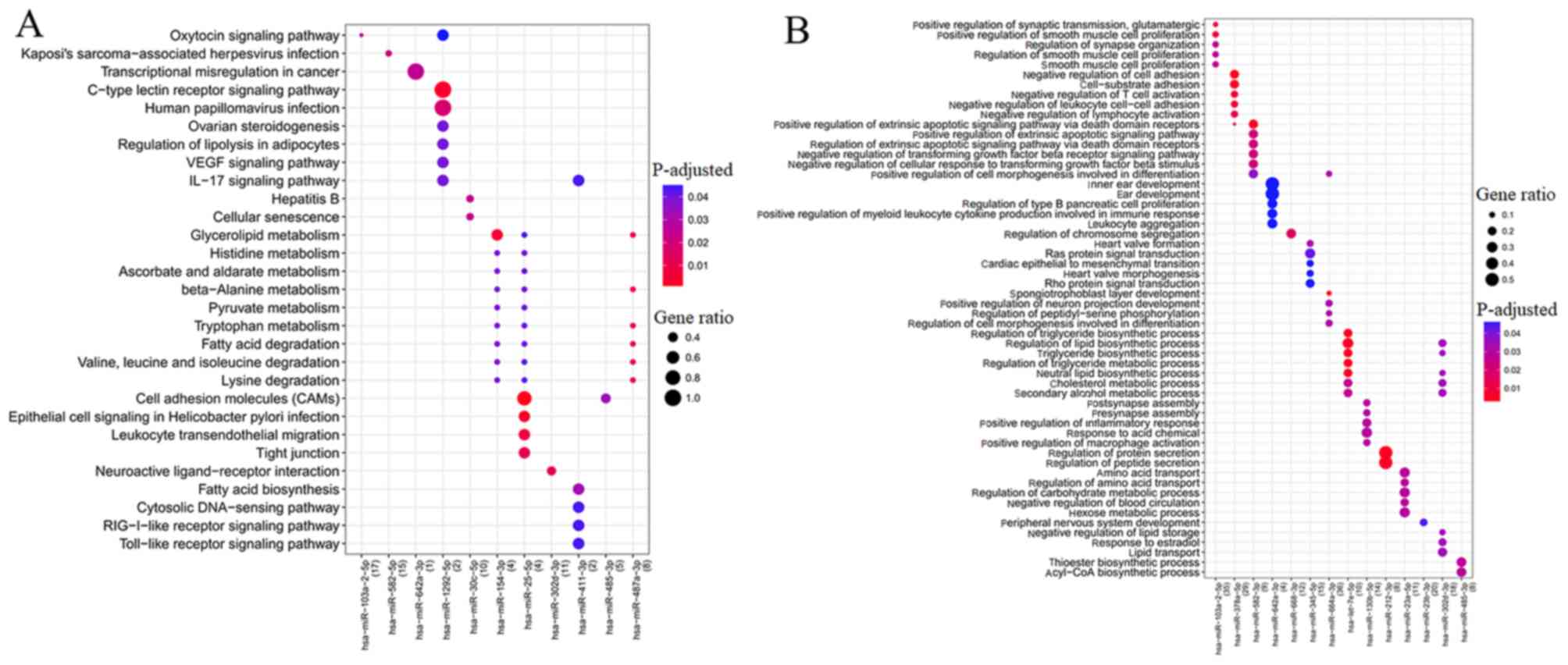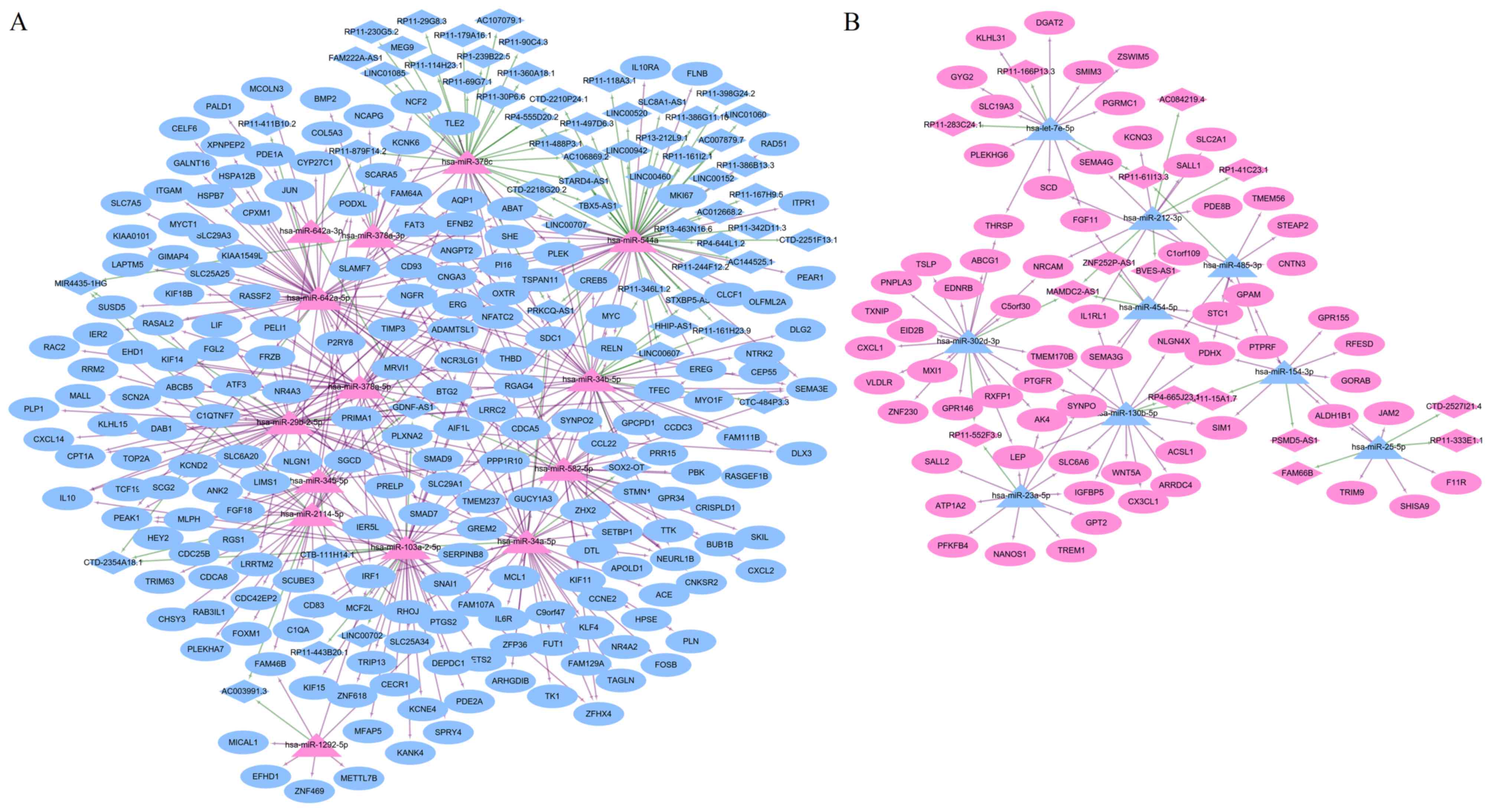An lncRNA‑miRNA‑mRNA ceRNA network for adipocyte differentiation from human adipose‑derived stem cells
- Authors:
- Published online on: March 21, 2019 https://doi.org/10.3892/mmr.2019.10067
- Pages: 4271-4287
-
Copyright: © Guo et al. This is an open access article distributed under the terms of Creative Commons Attribution License.
Abstract
Introduction
Breast reconstruction and augmentation are frequently performed surgical procedures worldwide due to the high prevalence of breast cancer (1) and cosmetic demand. Autologous fat transfer to the subcutaneous tissue is the most commonly used technique in these plastic and reconstructive surgical procedures as it appears to be relatively inexpensive, readily obtainable, safe and complication-free compared with artificial implants (2). However, the long-term replacement outcomes may not be satisfactory, which may be, in part, attributed to low graft survival and poor vascularization (3). Therefore, it is necessary to further improve the autologous fat grafting technique to overcome the above limitations.
Human adipose-derived stem cells (HASCs) are a population of pluripotent cells, which have a high proliferation capacity, possess preferential potential to differentiate into adipocytes and can secrete angiogenic growth factors. Therefore, the addition of HASCs to lipoaspirate may prevent graft volume loss and enhance blood vessel generation in the grafts. This hypothesis has been confirmed in previous clinical trials (4–6). However, the use of autologous HASCs has not been Food and Drug Administration-approved; this may be due to the fact that the reconstructive mechanism of HASCs remains to be fully elucidated. Therefore, it is essential to investigate the molecular mechanisms that induce the transition of HASCs towards adipocytes and attempt to develop a more effective combination to improve the efficacy of HASC therapy for breast reconstruction and augmentation (7).
Currently, several genes have been identified to be associated with adipogenesis for HASCs. Cytokine interleukin-1α (IL-1α) is demonstrated to evidently inhibit the proliferation and adipogenic differentiation of HASCs through the activation of nuclear factor (NF)-κB and extracellular signal-regulated kinase 1/2 pathways; and subsequent upregulation of pro-inflammatory cytokines, including interleukin (IL)-8, IL-6, C-C motif chemokine ligand 2 and IL-1β, in adipose-derived stem cells (8). A study by Strong et al (9) analyzed the overall cytokine profile of HASCs undergoing adipogenic differentiation and also found a decrease in the expression of IL-1, but reported increases in IL-12, IL-17 and intercellular adhesion molecule-1. By transcriptome profile analysis, Satish et al (10) identified several novel genes and signaling pathways involved in regulating adipogenesis, including periostin, protein phosphatase 1 regulatory inhibitor subunit 1A and fibroblast growth factor 11. MicroRNAs (miRNAs) are a class of small RNAs that are important for the regulation of cellular processes by downregulating gene expression via binding to the 3′-untranslated region. There is also evidence to indicate the roles of miRNAs in adipogenic differentiation. The levels of miRNA (miR)-27a and miR-27b have been found to be downregulated following the adipogenic induction of HASCs. The overexpression of miR-27a or miR-27b inhibits adipocyte differentiation by downregulating the expression of prohibitin; and the target association between miR-27a/b and prohibitin was confirmed using a luciferase reporter assay (11). miR-17-5p and miR-106a were shown to promote the adipogenic lineage commitment of HASCs by directly targeting bone morphogenetic protein 2 and subsequently increasing adipogenic CCAAT enhancer binding protein α (C/EBPα) and peroxisome proliferator activated receptor (PPAR)γ (12). In addition to miRNAs, long non-coding RNAs (lncRNAs) have emerged as important factors contributing to adipocyte differentiation in HASCs. Nuermaimaiti et al (13) demonstrated that the knockdown of HOXA11-AS1 inhibited adipocyte differentiation, leading to the suppression of adipogenic-related gene transcription in addition to decreased lipid accumulation in HASCs. The knockdown of MIR31HG also inhibited adipocyte differentiation, whereas the overexpression of MIR31HG promoted adipogenesis in vitro and in vivo (14). However, the adipogenic differentiation-related genes, miRNAs and lncRNAs of HASCs have received limited investigation.
Several scholars have put forward the competing endogenous RNAs (ceRNAs) hypothesis as an lncRNA-miRNA-mRNA link: LncRNAs may serve as molecular sponges for miRNAs and functionally liberate mRNA-targeted regulated by the aforementioned active miRNAs. Certain adipocyte differentiation-related lncRNA-miRNA-mRNA interaction axes have previously been obtained in bone marrow mesenchymal stem cells (BMSCs) (15,16), but not in HASCs.
The aim of the present study was to screen crucial miRNAs, lncRNAs and mRNAs associated with the adipocyte differentiation of HASCs by constructing the miRNA-lncRNA-mRNA ceRNA regulatory network using microarray data collected from a public database. The results of the present study may improve current understanding of the molecular mechanisms that induce the transition of HASCs towards adipocytes and provide targets for inducing adipogenic differentiation.
Materials and methods
Gene Expression Omnibus (GEO) dataset
The lncRNA, miRNA and mRNA expression profiles of HASCs prior to and following adipocyte differentiation were retrieved from the public GEO database (http://www.ncbi.nlm.nih.gov/geo/) under accession nos. GSE57593, GSE25715 and GSE61302 (10), respectively. The GSE57593 microarray dataset (platform: GPL18109, Agilent-038314 CBC Homo sapiens lncRNA + mRNA microarray V2.0) included samples from four undifferentiated HASCs and six differentiated adipocyte cells, which were induced following adipogenic medium culture for 3 and 6 days, with three replicates of each. The GSE25715 non-coding RNA sequencing dataset (platform: GPL9442, AB SOLiD System 3.0, Homo sapiens), included samples from four undifferentiated HASCs [two with adapter set A (from the 5′ to the 3′ end) and two with adapter set B (from the 3′ to the 5′ end)] and eight adipocyte differentiated cells that were induced using adipogenic medium for 3 and 8 days, with two replicates of each and using adapter sets A and B. The GSE61302 microarray dataset (platform: GPL570, Affymetrix Human Genome U133 Plus 2.0 Array) included samples from five undifferentiated HASCs and 10 differentiated adipocyte cells which were induced with adipogenic medium for 7 days (four replicates) and 21 days (six replicates).
Data preprocessing and differential expression analysis
For the microarray data, the raw data were preprocessed using the Robust Multichip Average algorithm (17) as implemented in the Bioconductor R package (version 3.4.1; http://www.bioconductor.org/packages/release/bioc/html/affy.html), including background correction, quantile normalization and median summarization. For the sequencing data, low expression value data (=0, 70%) were filtered.
In consideration of the different differentiated time, the present study only focused on the differentially expressed genes (DEGs), lncRNAs (DELs) and miRNAs (DEMs) between the undifferentiated and differentiated cells. The DEGs, DELs and DEMs were identified using the Linear Models for Microarray data method (18) in the Bioconductor R package (version 3.4.1; http://www.bioconductor.org/packages/release/bioc/html/limma.html). The empirical Bayes t-test was used to calculate the p-value, which was subsequently adjusted by the Benjamini-Hochberg (BH) procedure (19). Genes were considered differentially expressed if they met the following conditions: P-value (adjusted) P<0.05 and |logFC(fold change)| >1 (that is, FC>2). A hierarchical cluster heatmap was created using the R package pheatmap (version: 1.0.8; http://cran.r-project.org/web/packages/pheatmap) based on the Euclidean distance to observe the ability of the DEGs, DELs and DEMs to distinguish the differentiated from the undifferentiated samples.
Protein-protein interaction (PPI) network
To screen crucial genes, the DEGs were imported into PPI data that were collected from the Search Tool for the Retrieval of Interacting Genes (version 10.0; http://string db.org/) database (20). The PPIs with combined scores ≥0.4 (medium confidence) were selected to construct the PPI network, which was visualized using Cytoscape software (version 3.4; www.cytoscape.org/) (21). The network topological features, including the degree (number of interactions per node or protein), betweenness (number of shortest paths that pass through each node), and closeness centrality (average length of the shortest paths to access all other proteins in the network) were determined using the CytoNCA plugin in Cytoscape software (http://apps.cytoscape.org/apps/cytonca) (22) to rank the nodes in the PPI network and screen hub genes. Modules were identified to be significant with an Molecular Complex Detection (MCODE) score ≥4 and ≥6 nodes.
Furthermore, the MCODE (version:1.4.2, http://apps.cytoscape.org/apps/mcode) plugin of Cytoscape software was also used to identify functionally related and highly interconnected modules from the PPI network with a degree cut-off of 2, node score cut-off of 0.2, k-core of 2 and maximum depth of 100 (23).
ceRNA regulatory network construction
The DEM-related target genes were predicted using the miRWalk database (version 2.0; http://www.zmf.umm.uni-heidelberg.de/apps/zmf/mirwalk2) (24), which provides the largest collection of predicted and experimentally verified miR-target interactions with various miRNA databases, including miRWalk, miRanda, miRDB, miRMap, RNA22 and TargetScan. The miRNA-target gene interaction pairs were selected if they were predicted in at least five databases. The target genes were then overlapped with the DEGs to screen the DEM (upregulated)-DEG (downregulated) or DEM (downregulated)-DEG (upregulated) interaction pairs.
The miRWalk (version 2.0; http://www.zmf.umm.uni-heidelberg.de/apps/zmf/mirwalk2) (24) and lnCeDB (http://gyanxet-beta.com/lncedb/) (25) databases were used to screen the interactions between DELs and DEMs. The DEL (upregulated)-DEM (downregulated) and DEL (downregulated)-DEM (upregulated) interaction pairs were collected.
The DEL-DEM and DEM-DEG interactions were integrated to construct the lncRNA-miRNA-mRNA ceRNA network, which was visualized using Cytoscape software (version 3.4; www.cytoscape.org/) (21).
Function enrichment analysis
Gene Ontology (GO) and Kyoto Encyclopedia of Genes and Genomes (KEGG) pathway enrichment analyses were performed using the clusterProfiler tool (version 3.2.11; http://www.bioconductor.org/packages/release/bioc/html/clusterProfiler.html) to reveal the function of the DEGs in the PPI and the target genes of miRNAs. Adjusted P<0.05 using the BH method was set as the cut-off value (19).
Results
Differential expression analysis
Based on the given threshold (adjusted P<0.05 and |logFC| >1), a total of 925 DEGs were identified from 20,514 mRNAs between the undifferentiated HASCs and differentiated adipocyte cells, including 302 upregulated and 623 downregulated DEGs; 577 DELs were screened from 7,882 lncRNAs between the undifferentiated HASCs and differentiated adipocyte cells, including 323 upregulated and 254 downregulated DELs. A total of 35 DEMs were screened from 499 miRNAs between the undifferentiated HASCs and differentiated adipocyte cells (including 20 upregulated and 15 downregulated), based on the threshold of P<0.05 and |logFC| >1. The top 20 DEGs, DEMs and DELs are shown in Table I. The heatmap indicated that these DEGs (Fig. 1A), DEMs (Fig. 1B) and DELs (Fig. 1C) distinguished the differentiated from the undifferentiated samples.
PPI network analysis of DEGs to screen hub genes
A PPI network was constructed using the screened DEGs, which included 360 nodes (162 upregulated and 198 downregulated) and 1,381 interaction pairs (Fig. 2). According to the rank of three topological features, JUN, cyclin B1 (CCNB1), C-X-C motif chemokine ligand 10 (CXCL10), enolase 2 (ENO2), enoyl-CoA hydratase and 3-hydroxyacyl CoA dehydrogenase (EHHADH), protein tyrosine phosphatase, receptor type C (PTPRC), Rac family small GTPase 2 (RAC2), leptin (LEP) and kinase insert domain receptor (KDR) were considered as hub genes in the PPI network (Table II). Six significant functionally related and highly interconnected modules were extracted from the whole PPI network (Fig. 3; Table III). Hub gene CCNB1 was enriched in module 1, which was associated with cell cycle (Fig. 3A). Hub gene CXCL10 was enriched in module 2 (Fig. 3B), which was associated with several inflammation pathways, including the chemokine signaling pathway, cytokine-cytokine receptor interaction, IL-17 signaling pathway, and tumor necrosis factor (TNF) signaling pathway. Hub gene ENO2 and PTPRC were respectively enriched into module 3 (Fig. 3C) and 4 (Fig. 3D). Hub gene JUN in module 4 was enriched in the NOD-like receptor signaling pathway or infection. Hub gene LEP in module 5 (Fig. 3E) was important in the Janus kinase (JAK)-signal transducer and activator of transcription (STAT) signaling pathway. Hub gene EHHADH in module 6 (Fig. 3F) was amino acid- or glucose metabolism-related (Table IV; Fig. 4A). As hub gene PTPRC and ENO2 were respectively enriched into module 4 and 3, but they were not included in the pathway-related genes, GO enrichment analysis was also performed. As a result, PTPRC was predicted to be involved in positive regulation of cytosolic calcium ion concentration (Table V; Fig. 4B). The function of ENO2 was not predicted.
DEM-DEG regulatory association analysis
A total of 7,381 target genes were predicted for the 21 upregulated DEMs, and 5,841 were predicted for the 15 downregulated DEMs. Following overlapping with the DEGs, 654 interactions were obtained for the 21 upregulated DEMs and 247 downregulated DEGs, and 197 interactions were obtained for the 14 downregulated DEMs and 96 upregulated DEGs.
The target genes of five upregulated DEMs (hsa-miR-103a-2-5p, hsa-miR-582-5p, hsa-miR-642a-5p, hsa-miR-1292-5p and hsa-miR-30c-5p and) were enriched into 29 KEGG pathways, whereas 36 KEGG pathways were enriched for six downregulated DEMs (hsa-miR-302d-3p, hsa-miR-154-3p, hsa-miR-485-3p, hsa-miR-25-5p, hsa-miR-487a and hsa-miR-411-3p) (Fig. 5A). Among them, hsa-miR-302d-3p regulated hub gene LEP to be involved in neuroactive ligand-receptor interaction; whereas hsa-miR-487a targeted hub gene EHHADH for involvement in amino acid (β-alanine, lysine, valine, leucine and isoleucine) metabolism; hub gene CXCL10 regulated by hsa-miR-411-3p was involved in the IL-17 signaling pathway, Toll-like receptor signaling pathway, and TNF signaling pathway (Table VI).
Furthermore, GO biological process term enrichment analysis was also performed to predict the functions of DEMs (Fig. 5B). As a result, GO terms were enriched for nine upregulated DEMs (hsa-miR-103-5p, hsa-let-7e-5p, hsa-miR-212-3p, hsa-miR-345-5p, hsa-miR-378a-5p, hsa-miR-642a-3p, hsa-miR-582-3p, hsa-miR-664a-3p and hsa-miR-668-3p) and five downregulated DEMs (hsa-miR-302d-3p, hsa-miR-485-3p, hsa-miR-130b-5p, hsa-miR-23a-5p and hsa-miR-23b-5p). hsa-miR-378a-5p may regulate hub gene RAC2 to be involved in cell-substrate adhesion. hsa-miR-130b-5p, hsa-miR-23a-5p and hsa-miR-302d-3p may regulate hub gene LEP to be involved in regulation of inflammatory response and IL-8 secretion (Table VII).
ceRNA network
Using the miRWalk and InCeDB databases, 14 upregulated DEMs were predicted to regulate 60 downregulated DELs and nine downregulated DEMs were predicted to regulate 15 upregulated DELs. An lncRNA-miRNA-mRNA ceRNA network was subsequently established (Fig. 6A and B), in which 366 nodes (23 DEMs: 14 upregulated and nine downregulated; 268 DEGs: 67 upregulated and 201 downregulated; 75 DELs: 15 upregulated and 60 downregulated) and 560 interactions (450 DEL-DEM and 110 DEM-DEG) were present. In this ceRNA, upregulated RP11-552F3.9 (or RP11-15A1.7) may function as a ceRNA to respectively suppress the inhibitory effects of hsa-miR-23a-5p and hsa-miR-302d-3p (or hsa-miR-130b-5p) on LEP, resulting in its upregulated expression; whereas the downregulation of GDNF-AS1 may be insufficient to prevent the inhibitory effects of hsa-miR-378a-5p on hub gene RAC2, leading to its downregulated expression (Fig. 6A and B).
Discussion
The present study aimed to identify crucial mRNAs, miRNAs and lncRNAs for the adipocyte differentiation of HASCs based on a series of bioinformatics analyses, including PPI network construction, module analysis, miRNA-mRNA regulatory pair prediction, ceRNA network generation and function enrichment. In these analyses, the LEP gene was enriched and was regulated by RP11-552F3.9 (or RP11-15A1.7)-hsa-miR-23a-5p/hsa-miR-302d-3p (or hsa-miR-130b-5p), and involved in the inflammatory response, indicating that the LEP-related ceRNA axis may be important for the differentiation of adipose tissue-derived stem cells into adipocytes.
There is evidence demonstrating that LEP is important in adipocyte differentiation (26). Lee et al (27) observed that leptin treatment can promote lipid droplet formation and adipocyte differentiation, which was evaluated by the activity of glycerol-3-phosphate dehydrogenase activity, of HASCs. Additionally, the effect of leptin on adipocyte differentiation was found to be higher for HASCs than BMSCs (27). Another study indicated that, in BMSCs, leptin may accelerate osteogenic differentiation but inhibit adipocyte differentiation (28). Similarly, leptin was shown to have a suppressive effect on adipogenesis in dental pulp stem cells and periodontal ligament stem cells (29). These findings suggest that leptin may be a specific factor for regeneration of the subcutaneous fat layer using HASCs for tissue engineering. As expected, the LEP gene was also significantly upregulated in differentiated adipocyte samples compared with undifferentiated HASCs in the present study. It was predicted that the downstream of LEP may be involved in the JAK-STAT signaling pathway to mediate the inflammatory response via interaction with certain anti-inflammatory-related factors (IL4R, downregulated; Table IV; Fig. 3E). This prediction appears to have been indirectly verified by previous studies; it has been reported that leptin may have a promoting effect on the astroglial differentiation of stem cells through activation of the JAK-STAT pathway, with JAK-STAT inhibitors decreasing the expression of astrocyte marker leptin (30). STAT6 is reported to inhibit human IL-4 promoter activity in T cells and downregulate the gene expression of IL-4 (31). IL-4/IL4R can inhibit adipocyte differentiation by two mechanisms: Inhibiting adipogenesis via downregulating the expression of PPARγ and C/EBPα; and promoting lipolysis in mature adipocytes via enhancing the activity and translocation of hormone-sensitive lipase to decrease lipid deposits (32). However, the LEP-JAK-STAT-IL-4/IL4R signal pathways in the adipocyte differentiation of HASCs requires further experimental validation. In addition to the downstream pathways, the present study also analyzed the upstream non-coding RNAs of LEP, including miRNAs and lncRNAs, which were previously considered to be crucial for the adipogenic differentiation of HASCs (13,14,33–36). The results identified the RP11-552F3.9 (or RP11-15A1.7)-hsa-miR-23a-5p/hsa-miR-302d-3p (or hsa-miR-130b-5p)-LEP ceRNA axes. miR-130 has been shown to affect adipocyte differentiation from preadipocytes, with overexpressing miR-130 impairing adipogenesis and reducing miR-130-enhanced adipogenesis, and its potential target may be adipogenesis-related gene PPARγ (37). In addition, the inhibition of miR-23a has been reported to increase the adipogenic differentiation of BMSCs (38). In line with these findings, the present study found that hsa-miR-130b-5p and has-miR-23a-5p were downregulated in adipocyte differentiated HASCs. There have been no reports on the roles of miR-302d-3p and the above lncRNAs (RP11-552F3.9 and RP11-15A1.7) for adipocyte differentiation, indicating they may be novel targets identified by the present study.
RAC2 was identified as another hub gene that may be involved in the adipocyte differentiation of HASCs by miRNA-mRNA regulatory pair prediction and ceRNA network analysis. RAC2 was related to cell-substrate adhesion. It is well accepted that cell-substrate adhesion can control the fate of stem cells (39). A previous study showed that HASCs differentiated into adipocytes when the substrate stiffness decreased (40). Focal adhesion kinase (FAK) is a central protein involved in cell-substrate adhesion by Cas-Rac-lamellipodin signaling (41). The stimulation of Rac and increase in the activity of FAK enhanced cell tension by maintaining cell shape and matrix adhesion (42), whereas reduced cell stiffness and reduced adhesion strength have been observed in FAK-deficient cells (43). The inhibition of FAK has also been reported to lead to the elevation of adipogenic marker gene LEP and lipid accumulation in HASCs (43). These findings implicate the underlying anti-adipogenic activity of FAK and RAC. In line with these findings, the present study found that RAC2 was downregulated in adipocyte differentiated HASCs. Furthermore, it was predicted that RAC2 may be regulated by GDNF-AS1-hsa-miR-378a-5p. Previous evidence has shown that miR-378 is an adipogenesis-related miRNA in human adipocytes (44). The expression of miR-378a is upregulated in the adipose tissues of high fat diet-induced obese mice, and during the differentiation of preadipocytes (45,46). Investigations of the mechanism have revealed that miR-378 may induce adipogenesis by targeting mitogen-activated protein kinase 1 (45), E2F transcription factor 2 and Ras-related nuclear-binding protein 10 (46). Accordingly, it was hypothesized that hsa-miR-378a-5p may be upregulated in adipocyte differentiated HASCs, which was demonstrated in the present study. However, further experiments are required to confirm the role of this miRNA in HASC differentiation and its targeted interactions with RAC2. There are no previous reports on the roles of GDNF-AS1 in HASC differentiation, indicating it may also be a novel target identified by the present study.
Hub genes CXCL10 in module 2 and EHHADH in module 6 were shown to be respectively regulated by hsa-miR-411-3p and hsa-miR-487a, being involved in inflammatory and amino acid metabolism pathways for HASC differentiation. As reported for LEP above, inflammation promotes the adipocyte differentiation of HASCs, whereas CXCL10 is a well-known pro-inflammatory chemokine (47). Therefore, CXCL10 may be upregulated in adipocyte differentiated HASCs, which was confirmed in the present study. EHHADH has been reported as a downstream target upregulated by PPAR (48). PPAR is an important marker in stimulating adipogenesis (12). EHHADH may also be expressed at a high level in adipocyte differentiated HASCs, which was in consistent with the present study. These two miRNAs regulating CXCL10 and EHHADH have not been demonstrated to be responsible for HASC differentiation, which highlights potential directions in future investigations.
CCNB1, JUN and PTPRC were suggested to be important for adipocyte differentiation from HASCs according to the PPI network analysis. With reference to previous studies, high expression levels of CCNB1 (49) and JUN (50) may be positively associated with the proliferation of stem cells. Generally, the differentiation process can be executed only following weakening of the proliferation ability of stem cells. In the adipocyte differentiation of HASCs, CCNB1 and JUN may be downregulated, which was verified in the present study. PTPRC is also known as CD45, a JAK phosphatase, which negatively regulates cytokine receptor signaling via inhibiting the activity of STAT3 (51,52). According to the findings of LEP above, PTPRC may be downregulated for the adipocyte differentiation of HASCs, which was in line with the results of the present study.
There were some limitations in the present study. First, adipocyte differentiated cells were induced following different culture durations in the GSE57593, GSE25715 and GSE61302 datasets, which may lead to differences in the expression levels of the identified mRNAs, miRNAs and lncRNAs if the same samples were used for their detection. Second, the sample size of each dataset (GSE57593: Four undifferentiated HASCs and six adipocyte differentiated cells; GSE25715: Four undifferentiated HASCs and eight adipocyte differentiated cells: GSE61302: Five undifferentiated HASCs and 10 adipocyte differentiated cells) was small. Additional high-throughput sequencing experiments with larger samples are required to confirm the conclusions. Third, the present study comprised preliminary screening; however, further wet experiments, including quantitative-polymerase chain reaction analysis, western blotting, dual luciferase reporter assays, and knockout or overexpression in vitro and in vivo, are indispensable to confirm the expression levels of the identified target genes and validate the regulatory associations between DEMs and DELs/DEGs.
In conclusion, the present study preliminarily identified several crucial DEGs (LEP, RAC2, CXCL10, EHHADH CCNB1, JUN and PTPRC), DEMs (has-miR-130b-5p and has-miR-23a-5p, has-miR-302d-3p, has-miR-378a-5p, hsa-miR-411-3p and hsa-miR-487a) and DELs (RP11-552F3.9, RP11-15A1.7 and GDNF-AS1) for inducing the adipogenic differentiation of HASCs. Among these, the RP11-552F3.9 (or RP11-15A1.7)-hsa-miR-302d-3p-LEP ceRNA interaction axes may be particularly important and represents a novel mechanism for the adipogenic differentiation of HASCs. Further in vitro and in vivo investigations are required to confirm their roles in breast reconstruction and augmentation.
Acknowledgements
Not applicable.
Funding
No funding was received.
Availability of data and materials
The microarray data GSE57593, GSE25715 and GSE61302 were downloaded from the GEO database in NCBI (www.ncbi.nlm.nih.gov/geo/).
Authors' contributions
ZG and YC conceived and designed the original study. ZG conducted the bioinformatic analysis and drafted the manuscript. YC contributed to the acquisition and interpretation of data and revised the manuscript. Both authors read and approved the final manuscript.
Ethics approval and consent to participate
Not applicable.
Patient consent for publication
Not applicable.
Competing interests
The authors declare that they have no competing interests.
References
|
Ghoncheh M, Pournamdar Z and Salehiniya H: Incidence and mortality and epidemiology of breast cancer in the world. Asian Pac J Cancer Prev. 17:43–46. 2016. View Article : Google Scholar : PubMed/NCBI | |
|
Szychta P, Zadrozny M, Rykala J, Banasiak L and Witmanowski H: Autologous fat transfer to the subcutaneous tissue in the context of breast reconstructive procedures. Postepy Dermatol Alergol. 33:323–328. 2016. View Article : Google Scholar : PubMed/NCBI | |
|
Soares MA, Ezeamuzie OC, Ham MJ, Duckworth AM, Rabbani PS, Saadeh PB and Ceradini DJ: Targeted protection of donor graft vasculature using a phosphodiesterase inhibitor increases survival and predictability of autologous fat grafts. Plast Reconstr Surg. 135:488–499. 2015. View Article : Google Scholar : PubMed/NCBI | |
|
Kølle SF, Fischer-Nielsen A, Mathiasen AB, Elberg JJ, Oliveri RS, Glovinski PV, Kastrup J, Kirchhoff M, Rasmussen BS, Talman ML, et al: Enrichment of autologous fat grafts with ex-vivo expanded adipose tissue-derived stem cells for graft survival: A randomised placebo-controlled trial. Lancet. 382:1113–1120. 2013. View Article : Google Scholar : PubMed/NCBI | |
|
Sterodimas A, Faria JD, Nicaretta B and Boriani F: Autologous fat transplantation versus adipose-derived stem cell-enriched lipografts: A study. Aesthet Surg J. 31:682–693. 2011. View Article : Google Scholar : PubMed/NCBI | |
|
Tan SS, Zhi YN, Zhan W and Rozen W: Role of adipose-derived stem cells in fat grafting and reconstructive surgery. J Cutan Aesthet Surg. 9:152–156. 2016. View Article : Google Scholar : PubMed/NCBI | |
|
Feng H, Qiu L, Zhang T, Yu H, Ma X, Su Y, Zheng H, Wang Y and Yi C: Heat-Shock Protein 70 Overexpression in adipose-derived stem cells enhances fat graft survival. Ann Plast Surg. 78:460–466. 2017. View Article : Google Scholar : PubMed/NCBI | |
|
Sun X, Zou T, Zuo C, Zhang M, Shi B, Jiang Z, Cui H, Liao X, Li X, Tang Y, et al: IL-1α inhibits proliferation and adipogenic differentiation of human adipose-derived mesenchymal stem cells through NF-κB- and ERK1/2- mediated proinflammatory cytokines. Cell Biol Int. 42:794–803. 2018. View Article : Google Scholar : PubMed/NCBI | |
|
Strong AL, Gimble JM and Bunnell BA: Analysis of the pro- and anti-inflammatory cytokines secreted by adult stem cells during differentiation. Stem Cells Int. 2015:4124672015. View Article : Google Scholar : PubMed/NCBI | |
|
Satish L, Krill-Burger JM, Gallo PH, Etages SD, Liu F, Philips BJ, Ravuri S, Marra KG, Laframboise WA, Kathju S and Rubin JP: Expression analysis of human adipose-derived stem cells during in vitro differentiation to an adipocyte lineage. BMC Med Genomics. 8:412015. View Article : Google Scholar : PubMed/NCBI | |
|
Kang T, Lu W, Xu W, Anderson L, Bacanamwo M, Thompson W, Chen YE and Liu D: MicroRNA-27 (miR-27) targets prohibitin and impairs adipocyte differentiation and mitochondrial function in human adipose-derived stem Cells. J Biol Chem. 288:34394–34402. 2013. View Article : Google Scholar : PubMed/NCBI | |
|
Li H, Li T, Wang S, Wei J, Fan J, Li J, Han Q, Liao L, Shao C and Zhao RC: miR-17-5p and miR-106a are involved in the balance between osteogenic and adipogenic differentiation of adipose-derived mesenchymal stem cells. Stem Cell Res. 10:313–324. 2013. View Article : Google Scholar : PubMed/NCBI | |
|
Nuermaimaiti N, Liu J, Liang X, Jiao Y, Zhang D, Liu L, Meng X and Guan Y: Effect of lncRNA HOXA11-AS1 on adipocyte differentiation in human adipose-derived stem cells. Biochem Biophys Res Commun. 495:1878–1884. 2018. View Article : Google Scholar : PubMed/NCBI | |
|
Huang Y, Jin C, Zheng Y, Li X, Shan Z, Zhang Y, Jia L and Li W: Knockdown of lncRNA MIR31HG inhibits adipocyte differentiation of human adipose-derived stem cells via histone modification of FABP4. Sci Rep. 7:80802017. View Article : Google Scholar : PubMed/NCBI | |
|
Shang G, Wang Y, Xu Y, Zhang S, Sun X, Guan H, Zhao X, Wang Y, Li Y and Zhao G: Long non-coding RNA TCONS_00041960 enhances osteogenesis and inhibits adipogenesis of rat bone marrow mesenchymal stem cell by targeting miR-204-5p and miR-125a-3p. J Cell Physiol. 233:6041–6051. 2018. View Article : Google Scholar : PubMed/NCBI | |
|
Li M, Xie Z, Wang P, Li J, Liu W, Tang S, Liu Z, Wu X, Wu Y and Shen H: The long noncoding RNA GAS5 negatively regulates the adipogenic differentiation of MSCs by modulating the miR-18a/CTGF axis as a ceRNA. Cell Death Dis. 9:5542007. View Article : Google Scholar | |
|
Irizarry RA, Hobbs B, Collin F, Beazer-Barclay YD, Antonellis KJ, Scherf U and Speed TP: Exploration, normalization, and summaries of high density oligonucleotide array probe level data. Biostatistics. 4:249–264. 2003. View Article : Google Scholar : PubMed/NCBI | |
|
Ritchie ME, Phipson B, Wu D, Hu Y, Law CW, Shi W and Smyth GK: limma powers differential expression analyses for RNA-sequencing and microarray studies. Nucleic Acids Res. 43:e472015. View Article : Google Scholar : PubMed/NCBI | |
|
Thissen D, Steinberg L and Kuang D: Quick and easy implementation of the benjamini-hochberg procedure for controlling the false positive rate in multiple comparisons. J Educ Behav Stat. 27:77–83. 2002. View Article : Google Scholar | |
|
Szklarczyk D, Franceschini A, Wyder S, Forslund K, Heller D, Huerta-Cepas J, Simonovic M, Roth A, Santos A, Tsafou KP, et al: STRING v10: Protein-protein interaction networks, integrated over the tree of life. Nucleic Acids Res. 43:Database Issue. D447–D452. 2015. View Article : Google Scholar : PubMed/NCBI | |
|
Kohl M, Wiese S and Warscheid B: Cytoscape: Software for visualization and analysis of biological networks. Methods Mol Biol. 696:291–303. 2011. View Article : Google Scholar : PubMed/NCBI | |
|
Tang Y, Li M, Wang J, Pan Y and Wu FX: CytoNCA: A cytoscape plugin for centrality analysis and evaluation of protein interaction networks. Biosystems. 127:67–72. 2015. View Article : Google Scholar : PubMed/NCBI | |
|
Bader GD and Hogue CW: An automated method for finding molecular complexes in large protein interaction networks. BMC Bioinformatics. 4:22003. View Article : Google Scholar : PubMed/NCBI | |
|
Dweep H and Gretz N: miRWalk2. 0: A comprehensive atlas of microRNA-target interactions. Nat Methods. 12:6972015. View Article : Google Scholar : PubMed/NCBI | |
|
Das S, Ghosal S, Sen R and Chakrabarti J: lnCeDB: Database of human long noncoding RNA acting as competing endogenous RNA. PLoS One. 9:e989652014. View Article : Google Scholar : PubMed/NCBI | |
|
Kleiman A, Keats EC, Chan NG and Khan ZA: Elevated IGF2 prevents leptin induction and terminal adipocyte differentiation in hemangioma stem cells. Exp Mol Pathol. 94:126–136. 2013. View Article : Google Scholar : PubMed/NCBI | |
|
Lee HS, Jang H, Jin OP, Choi J, Youm JH and Hong ST: Effect of leptin on the differentiation of adipose tissue-derived and bone marrow stromal cells into adipocytes. Tissue Eng Regen Med. 6:1134–1138. 2009. | |
|
Thomas T, Gori F, Khosla S, Jensen MD, Burguera B and Riggs BL: Leptin acts on human marrow stromal cells to enhance differentiation to osteoblasts and to inhibit differentiation to adipocytes. Endocrinology. 140:1630–1638. 1999. View Article : Google Scholar : PubMed/NCBI | |
|
Um S, Choi JR, Lee JH, Zhang Q and Seo B: Effect of leptin on differentiation of human dental stem cells. Oral Dis. 17:662–669. 2011. View Article : Google Scholar : PubMed/NCBI | |
|
Wang YN, Yang M, Yu LH, Guo J, Chen N and He L: Leptin play the key role in astroglial differentiation of mouse neural stem cells and regulated the STAT3 signaling through Jak-STAT3 pathway. Sichuan Da Xue Xue Bao Yi Xue Ban. 45:552–556. 2014.(In Chinese). PubMed/NCBI | |
|
Georas SN, Cumberland JE, Burke TF, Chen R, Schindler U and Casolaro V: Stat6 inhibits human interleukin-4 promoter activity in T cells. Blood. 92:4529–4538. 1998.PubMed/NCBI | |
|
Tsao CH, Shiau MY, Chuang PH, Chang YH and Hwang J: Interleukin-4 regulates lipid metabolism by inhibiting adipogenesis and promoting lipolysis. J Lipid Res. 55:385–397. 2014. View Article : Google Scholar : PubMed/NCBI | |
|
Shin KK, Kim YS, Kim JY, Bae YC and Jung JS: miR-137 controls proliferation and differentiation of human adipose tissue stromal cells. Cell Physiol Biochem. 33:758–768. 2014. View Article : Google Scholar : PubMed/NCBI | |
|
Huang S, Wang S, Bian C, Yang Z, Zhou H, Zeng Y, Li H, Han Q and Zhao RC: Upregulation of miR-22 promotes osteogenic differentiation and inhibits adipogenic differentiation of human adipose tissue-derived mesenchymal stem cells by repressing HDAC6 protein expression. Stem Cells Dev. 21:2531–2540. 2012. View Article : Google Scholar : PubMed/NCBI | |
|
Yang Z, Bian C, Zhou H, Huang S, Wang S, Liao L and Zhao RC: MicroRNA hsa-miR-138 inhibits adipogenic differentiation of human adipose tissue-derived mesenchymal stem cells through adenovirus EID-1. Stem Cells Dev. 20:259–267. 2011. View Article : Google Scholar : PubMed/NCBI | |
|
Kim YJ, Hwang SJ, Yong CB and Jin SJ: MiR-21 regulates adipogenic differentiation through the modulation of TGF-β signaling in mesenchymal stem cells derived from human adipose tissue. Stem Cells. 27:3093–3102. 2009.PubMed/NCBI | |
|
Lee EK, Mi JL, Abdelmohsen K, Kim W, Kim MM, Srikantan S, Martindale JL, Hutchison ER, Kim HH, Marasa BS, et al: miR-130 suppresses adipogenesis by inhibiting peroxisome proliferator-activated receptor gamma expression. Mol Cell Biol. 31:626–638. 2011. View Article : Google Scholar : PubMed/NCBI | |
|
Guo Q, Chen Y, Guo L, Jiang T and Lin Z: miR-23a/b regulates the balance between osteoblast and adipocyte differentiation in bone marrow mesenchymal stem cells. Bone Res. 4:160222016. View Article : Google Scholar : PubMed/NCBI | |
|
Kang JM, Han M, Park IS, Jung Y and Kim SH and Kim SH: Adhesion and differentiation of adipose-derived stem cells on a substrate with immobilized fibroblast growth factor. Acta Biomater. 8:1759–1767. 2012. View Article : Google Scholar : PubMed/NCBI | |
|
Young DA, Yu SC, Engler AJ and Christman KL: Stimulation of adipogenesis of adult adipose-derived stem cells using substrates that mimic the stiffness of adipose tissue. Biomaterials. 34:8581–8588. 2013. View Article : Google Scholar : PubMed/NCBI | |
|
Bae YH, Mui KL, Hsu BY, Liu SL, Cretu A, Razinia Z, Xu T, Puré E and Assoian RK: A FAK-Cas-Rac-lamellipodin signaling module transduces extracellular matrix stiffness into mechanosensitive cell cycling. Sci Signal. 7:ra572014. View Article : Google Scholar : PubMed/NCBI | |
|
Hyväri L, Ojansivu M, Juntunen M, Kartasalo K, Miettinen S and Vanhatupa S: Focal adhesion kinase and ROCK signaling are switch-like regulators of human adipose stem cell differentiation towards osteogenic and adipogenic lineages. Stem Cells Int. 2018:21906572018. View Article : Google Scholar : PubMed/NCBI | |
|
Le TN, Oscar C, Mouw JK, Sharmila C, Hector M, Angel M, Jillian R, Keely PJ, Weaver VM and Lindsay H: Loss of miR-203 regulates cell shape and matrix adhesion through ROBO1/Rac/FAK in response to stiffness. J Cell Biol. 212:707–719. 2016. View Article : Google Scholar : PubMed/NCBI | |
|
Xu LL, Shi CM, Xu GF, Chen L, Zhu LL, Zhu L, Guo XR, Xu MY and Ji CB: TNF-α, IL-6, and leptin increase the expression of miR-378, an adipogenesis-related microRNA in human adipocytes. Cell Biochem Biophys. 70:771–776. 2014. View Article : Google Scholar : PubMed/NCBI | |
|
Huang N, Wang J, Xie W, Lyu Q, Wu J, He J, Qiu W, Xu N and Zhang Y: MiR-378a-3p enhances adipogenesis by targeting mitogen-activated protein kinase 1. Biochem Biophys Res Commun. 457:37–42. 2015. View Article : Google Scholar : PubMed/NCBI | |
|
Liu SY, Zhang YY, Gao Y, Zhang LJ, Chen HY, Zhou Q, Chai ML, Li QY, Jiang H, Yuan B, et al: MiR-378 plays an important role in the differentiation of bovine preadipocytes. Cell Physiol Biochem. 36:1552–1562. 2015. View Article : Google Scholar : PubMed/NCBI | |
|
Gao B, Lin J, Jiang Z, Yang Z, Yu H, Ding L, Yu M, Cui Q, Dunavin N, Zhang M and Li M: Upregulation of chemokine CXCL10 enhances chronic pulmonary inflammation in tree shrew collagen-induced arthritis. Sci Rep. 8:99932018. View Article : Google Scholar : PubMed/NCBI | |
|
Lu YF, Xu YY, Jin F, Wu Q, Shi JS and Liu J: Icariin is a PPARα activator inducing lipid metabolic gene expression in mice. Molecules. 19:181792014. View Article : Google Scholar : PubMed/NCBI | |
|
Fujii-Yamamoto H, Kim JM, Arai K and Masai H: Cell cycle and developmental regulations of replication factors in mouse embryonic stem cells. J Biol Chem. 280:12976–12987. 2005. View Article : Google Scholar : PubMed/NCBI | |
|
Jiao X, Katiyar S, Willmarth NE, Liu M, Ma X, Flomenberg N, Lisanti MP and Pestell RG: c-Jun induces mammary epithelial cellular invasion and breast cancer stem cell expansion. J Biol Chem. 285:8218–8226. 2010. View Article : Google Scholar : PubMed/NCBI | |
|
Irie-Sasaki J, Sasaki T, Matsumoto W, Opavsky A, Cheng M, Welstead G, Griffiths E, Krawczyk C, Richardson CD, Aitken K, et al: CD45 is a JAK phosphatase and negatively regulates cytokine receptor signalling. Nature. 409:349–354. 2001. View Article : Google Scholar : PubMed/NCBI | |
|
Kumar V, Cheng P, Condamine T, Mony S, Languino L, McCaffrey J, Hockstein N, Guarino M, Masters G, Penman E, et al: CD45 phosphatase inhibits STAT3 transcription factor activity in myeloid cells and promotes tumor-associated macrophage differentiation. Immunity. 44:303–315. 2016. View Article : Google Scholar : PubMed/NCBI |



